automatic transmission SATURN VUE 2008 Owners Manual
[x] Cancel search | Manufacturer: SATURN, Model Year: 2008, Model line: VUE, Model: SATURN VUE 2008Pages: 412, PDF Size: 2.78 MB
Page 79 of 412
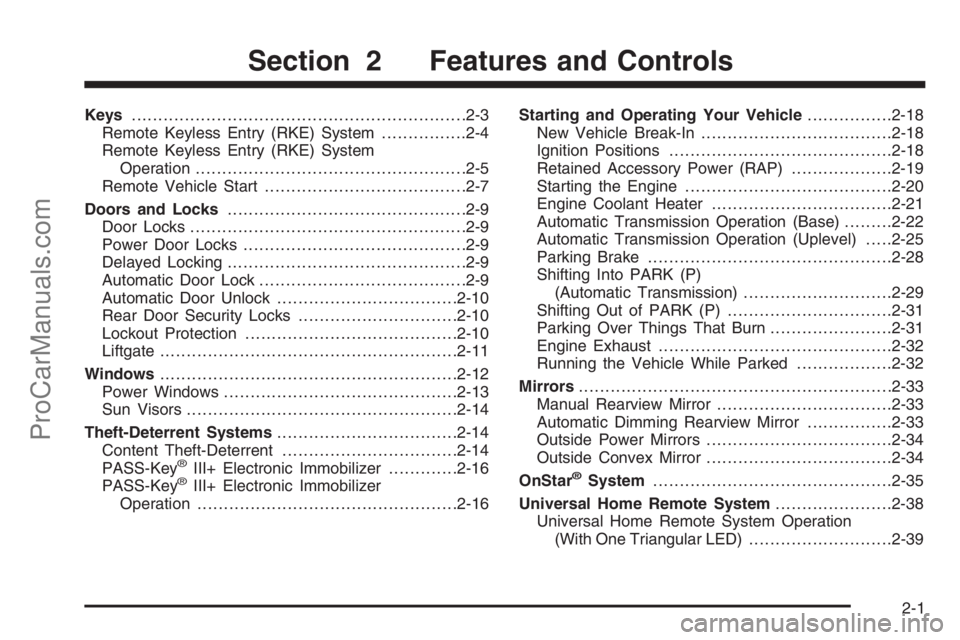
Keys...............................................................2-3
Remote Keyless Entry (RKE) System................2-4
Remote Keyless Entry (RKE) System
Operation...................................................2-5
Remote Vehicle Start......................................2-7
Doors and Locks.............................................2-9
Door Locks....................................................2-9
Power Door Locks..........................................2-9
Delayed Locking.............................................2-9
Automatic Door Lock.......................................2-9
Automatic Door Unlock..................................2-10
Rear Door Security Locks..............................2-10
Lockout Protection........................................2-10
Liftgate........................................................2-11
Windows........................................................2-12
Power Windows............................................2-13
Sun Visors...................................................2-14
Theft-Deterrent Systems..................................2-14
Content Theft-Deterrent.................................2-14
PASS-Key
®III+ Electronic Immobilizer.............2-16
PASS-Key®III+ Electronic Immobilizer
Operation.................................................2-16Starting and Operating Your Vehicle................2-18
New Vehicle Break-In....................................2-18
Ignition Positions..........................................2-18
Retained Accessory Power (RAP)...................2-19
Starting the Engine.......................................2-20
Engine Coolant Heater..................................2-21
Automatic Transmission Operation (Base).........2-22
Automatic Transmission Operation (Uplevel).....2-25
Parking Brake..............................................2-28
Shifting Into PARK (P)
(Automatic Transmission)............................2-29
Shifting Out of PARK (P)...............................2-31
Parking Over Things That Burn.......................2-31
Engine Exhaust............................................2-32
Running the Vehicle While Parked..................2-32
Mirrors...........................................................2-33
Manual Rearview Mirror.................................2-33
Automatic Dimming Rearview Mirror................2-33
Outside Power Mirrors...................................2-34
Outside Convex Mirror...................................2-34
OnStar®System.............................................2-35
Universal Home Remote System......................2-38
Universal Home Remote System Operation
(With One Triangular LED)...........................2-39
Section 2 Features and Controls
2-1
ProCarManuals.com
Page 100 of 412
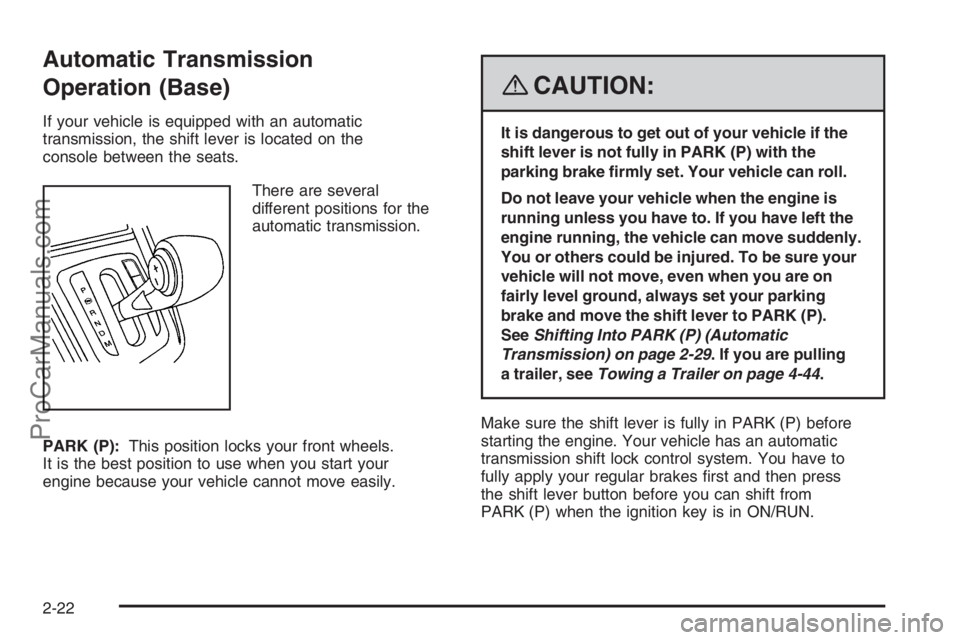
Automatic Transmission
Operation (Base)
If your vehicle is equipped with an automatic
transmission, the shift lever is located on the
console between the seats.
There are several
different positions for the
automatic transmission.
PARK (P):This position locks your front wheels.
It is the best position to use when you start your
engine because your vehicle cannot move easily.
{CAUTION:
It is dangerous to get out of your vehicle if the
shift lever is not fully in PARK (P) with the
parking brake �rmly set. Your vehicle can roll.
Do not leave your vehicle when the engine is
running unless you have to. If you have left the
engine running, the vehicle can move suddenly.
You or others could be injured. To be sure your
vehicle will not move, even when you are on
fairly level ground, always set your parking
brake and move the shift lever to PARK (P).
SeeShifting Into PARK (P) (Automatic
Transmission) on page 2-29. If you are pulling
a trailer, seeTowing a Trailer on page 4-44.
Make sure the shift lever is fully in PARK (P) before
starting the engine. Your vehicle has an automatic
transmission shift lock control system. You have to
fully apply your regular brakes �rst and then press
the shift lever button before you can shift from
PARK (P) when the ignition key is in ON/RUN.
2-22
ProCarManuals.com
Page 101 of 412
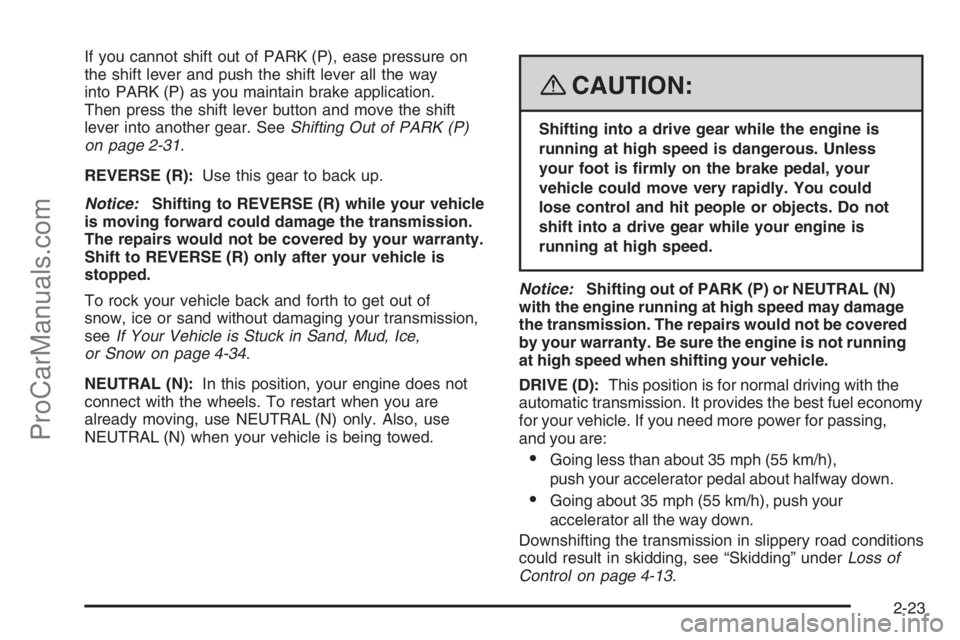
If you cannot shift out of PARK (P), ease pressure on
the shift lever and push the shift lever all the way
into PARK (P) as you maintain brake application.
Then press the shift lever button and move the shift
lever into another gear. SeeShifting Out of PARK (P)
on page 2-31.
REVERSE (R):Use this gear to back up.
Notice:Shifting to REVERSE (R) while your vehicle
is moving forward could damage the transmission.
The repairs would not be covered by your warranty.
Shift to REVERSE (R) only after your vehicle is
stopped.
To rock your vehicle back and forth to get out of
snow, ice or sand without damaging your transmission,
seeIf Your Vehicle is Stuck in Sand, Mud, Ice,
or Snow on page 4-34.
NEUTRAL (N):In this position, your engine does not
connect with the wheels. To restart when you are
already moving, use NEUTRAL (N) only. Also, use
NEUTRAL (N) when your vehicle is being towed.
{CAUTION:
Shifting into a drive gear while the engine is
running at high speed is dangerous. Unless
your foot is �rmly on the brake pedal, your
vehicle could move very rapidly. You could
lose control and hit people or objects. Do not
shift into a drive gear while your engine is
running at high speed.
Notice:Shifting out of PARK (P) or NEUTRAL (N)
with the engine running at high speed may damage
the transmission. The repairs would not be covered
by your warranty. Be sure the engine is not running
at high speed when shifting your vehicle.
DRIVE (D):This position is for normal driving with the
automatic transmission. It provides the best fuel economy
for your vehicle. If you need more power for passing,
and you are:
Going less than about 35 mph (55 km/h),
push your accelerator pedal about halfway down.
Going about 35 mph (55 km/h), push your
accelerator all the way down.
Downshifting the transmission in slippery road conditions
could result in skidding, see “Skidding” underLoss of
Control on page 4-13.
2-23
ProCarManuals.com
Page 102 of 412

MANUAL (M):This position allows you to change
gears similar to a manual transmission. If your vehicle
has this feature, see Manual Shift Mode.
Notice:Spinning the tires or holding the vehicle
in one place on a hill using only the accelerator
pedal may damage the transmission. The repair will
not be covered by your warranty. If you are stuck,
do not spin the tires. When stopping on a hill,
use the brakes to hold the vehicle in place.
Manual Shift Mode (MSM)
(Automatic Transmission)
To use this feature, do the following:
1. Move the shift lever from DRIVE (D) rearward to
the MANUAL MODE (M).
The six-speed transmission will downshift to a
lower gear and the instrument panel will display
the gear range selected. If equipped with a
4-speed transmission it will display a three (3) for
third gear range.
When coming to a stop in the manual position, the
vehicle will automatically shift to FIRST (1) gear.
2. Press the plus (+) button to upshift or the minus (−)
button to downshift.While using the MSM feature the vehicle will have
sportier performance. You can use this when driving
hilly roads to stay in gear longer or to downshift for
more power or engine braking.
The transmission will only allow you to shift into a gear
range appropriate for the vehicle speed.
The transmission will not automatically shift to
the next higher gear range without pressing
the button on the shifter handle.
The transmission will not allow shifting to the next
lower gear if the vehicle speed is too high.
If the vehicle does not respond to a gear change,
or detects a problem with the transmission, the range
of gears may be reduced and the Malfunction Indicator
Lamp will come on. SeeMalfunction Indicator Lamp
on page 3-41.
2-24
ProCarManuals.com
Page 103 of 412
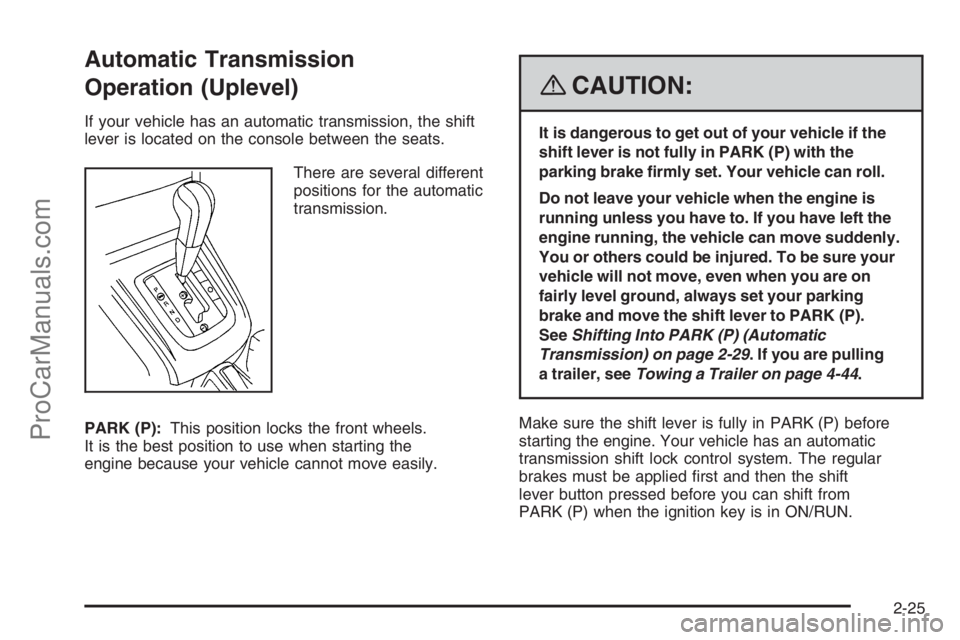
Automatic Transmission
Operation (Uplevel)
If your vehicle has an automatic transmission, the shift
lever is located on the console between the seats.
There are several different
positions for the automatic
transmission.
PARK (P):This position locks the front wheels.
It is the best position to use when starting the
engine because your vehicle cannot move easily.
{CAUTION:
It is dangerous to get out of your vehicle if the
shift lever is not fully in PARK (P) with the
parking brake �rmly set. Your vehicle can roll.
Do not leave your vehicle when the engine is
running unless you have to. If you have left the
engine running, the vehicle can move suddenly.
You or others could be injured. To be sure your
vehicle will not move, even when you are on
fairly level ground, always set your parking
brake and move the shift lever to PARK (P).
SeeShifting Into PARK (P) (Automatic
Transmission) on page 2-29. If you are pulling
a trailer, seeTowing a Trailer on page 4-44.
Make sure the shift lever is fully in PARK (P) before
starting the engine. Your vehicle has an automatic
transmission shift lock control system. The regular
brakes must be applied �rst and then the shift
lever button pressed before you can shift from
PARK (P) when the ignition key is in ON/RUN.
2-25
ProCarManuals.com
Page 104 of 412
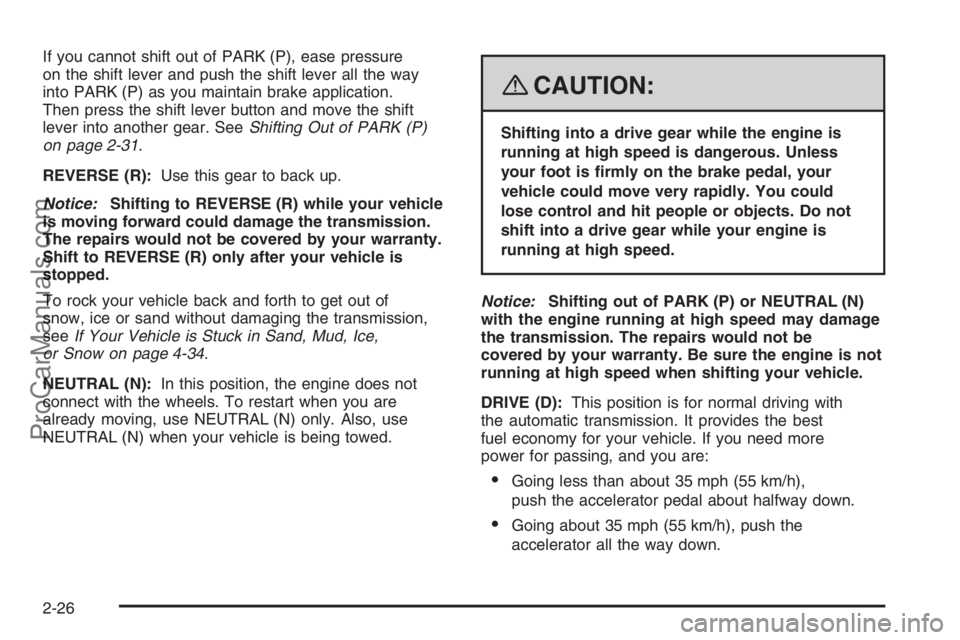
If you cannot shift out of PARK (P), ease pressure
on the shift lever and push the shift lever all the way
into PARK (P) as you maintain brake application.
Then press the shift lever button and move the shift
lever into another gear. SeeShifting Out of PARK (P)
on page 2-31.
REVERSE (R):Use this gear to back up.
Notice:Shifting to REVERSE (R) while your vehicle
is moving forward could damage the transmission.
The repairs would not be covered by your warranty.
Shift to REVERSE (R) only after your vehicle is
stopped.
To rock your vehicle back and forth to get out of
snow, ice or sand without damaging the transmission,
seeIf Your Vehicle is Stuck in Sand, Mud, Ice,
or Snow on page 4-34.
NEUTRAL (N):In this position, the engine does not
connect with the wheels. To restart when you are
already moving, use NEUTRAL (N) only. Also, use
NEUTRAL (N) when your vehicle is being towed.
{CAUTION:
Shifting into a drive gear while the engine is
running at high speed is dangerous. Unless
your foot is �rmly on the brake pedal, your
vehicle could move very rapidly. You could
lose control and hit people or objects. Do not
shift into a drive gear while your engine is
running at high speed.
Notice:Shifting out of PARK (P) or NEUTRAL (N)
with the engine running at high speed may damage
the transmission. The repairs would not be
covered by your warranty. Be sure the engine is not
running at high speed when shifting your vehicle.
DRIVE (D):This position is for normal driving with
the automatic transmission. It provides the best
fuel economy for your vehicle. If you need more
power for passing, and you are:
Going less than about 35 mph (55 km/h),
push the accelerator pedal about halfway down.
Going about 35 mph (55 km/h), push the
accelerator all the way down.
2-26
ProCarManuals.com
Page 105 of 412

Downshifting the transmission in slippery road conditions
could result in skidding, see “Skidding” underLoss of
Control on page 4-13.
Notice:Spinning the tires or holding the vehicle
in one place on a hill using only the accelerator
pedal may damage the transmission. The repair
will not be covered by your warranty. If you
are stuck, do not spin the tires. When stopping on
a hill, use the brakes to hold the vehicle in place.
Manual Shift Mode (MSM)
(Automatic Transmission)
To use this feature, do the following:
1. Move the shift lever from DRIVE (D) to the left into
the manual gate.
While driving in manual shift mode, the transmission
will remain in the driver gear selected. When coming
to a stop in the manual position, the vehicle will
automatically shift to FIRST (1) gear.
2. Push the shift lever forward toward the plus (+) to
upshift or rearward toward the minus (−) to downshift.
The instrument panel will display the actual gear
selected.In manual shift mode all six forward gears can be
selected.
While using the MSM feature the vehicle will have
operation similar to a manual transmission. You can use
this for sport driving or when driving hilly roads to stay in
gear longer or to downshift for more power or engine
braking.
The transmission will only allow you to shift into gears
appropriate for the vehicle speed:
The transmission will not automatically shift to the
next higher gear without moving the shift lever.
The transmission will not allow shifting to the next
lower gear if the vehicle speed is too high.
If the vehicle does not respond to a gear change, or
detects a problem with the transmission, the range
of gears may be reduced and the Malfunction Indicator
Lamp will come on. SeeMalfunction Indicator Lamp
on page 3-41.
2-27
ProCarManuals.com
Page 107 of 412
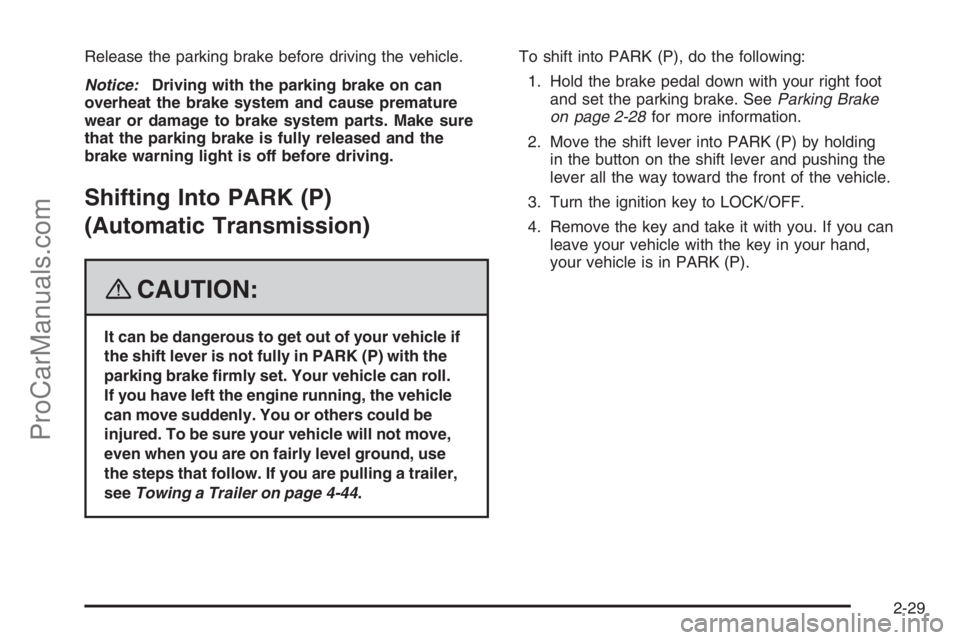
Release the parking brake before driving the vehicle.
Notice:Driving with the parking brake on can
overheat the brake system and cause premature
wear or damage to brake system parts. Make sure
that the parking brake is fully released and the
brake warning light is off before driving.
Shifting Into PARK (P)
(Automatic Transmission)
{CAUTION:
It can be dangerous to get out of your vehicle if
the shift lever is not fully in PARK (P) with the
parking brake �rmly set. Your vehicle can roll.
If you have left the engine running, the vehicle
can move suddenly. You or others could be
injured. To be sure your vehicle will not move,
even when you are on fairly level ground, use
the steps that follow. If you are pulling a trailer,
seeTowing a Trailer on page 4-44.To shift into PARK (P), do the following:
1. Hold the brake pedal down with your right foot
and set the parking brake. SeeParking Brake
on page 2-28for more information.
2. Move the shift lever into PARK (P) by holding
in the button on the shift lever and pushing the
lever all the way toward the front of the vehicle.
3. Turn the ignition key to LOCK/OFF.
4. Remove the key and take it with you. If you can
leave your vehicle with the key in your hand,
your vehicle is in PARK (P).
2-29
ProCarManuals.com
Page 108 of 412
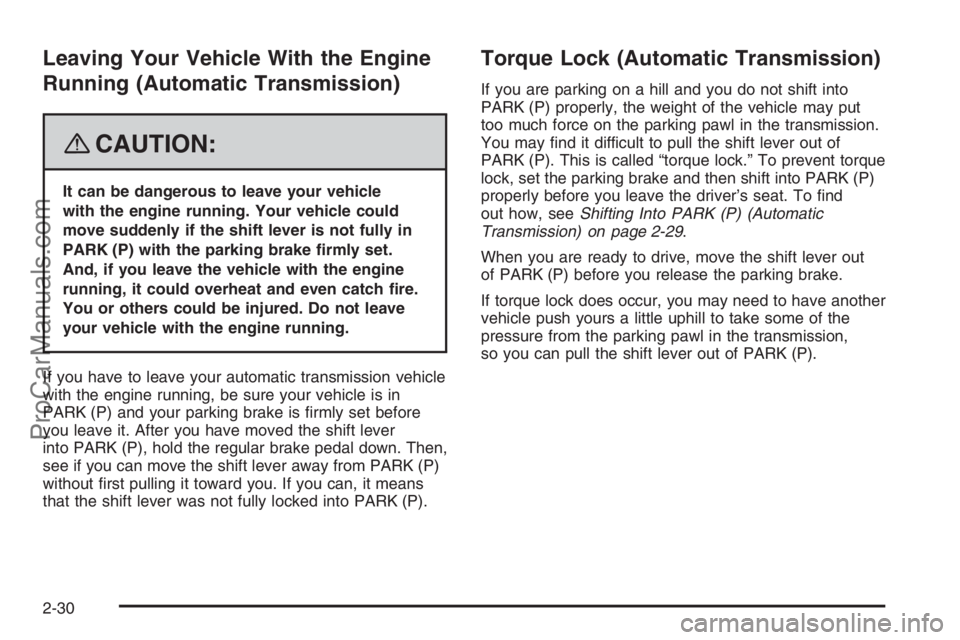
Leaving Your Vehicle With the Engine
Running (Automatic Transmission)
{CAUTION:
It can be dangerous to leave your vehicle
with the engine running. Your vehicle could
move suddenly if the shift lever is not fully in
PARK (P) with the parking brake �rmly set.
And, if you leave the vehicle with the engine
running, it could overheat and even catch �re.
You or others could be injured. Do not leave
your vehicle with the engine running.
If you have to leave your automatic transmission vehicle
with the engine running, be sure your vehicle is in
PARK (P) and your parking brake is �rmly set before
you leave it. After you have moved the shift lever
into PARK (P), hold the regular brake pedal down. Then,
see if you can move the shift lever away from PARK (P)
without �rst pulling it toward you. If you can, it means
that the shift lever was not fully locked into PARK (P).
Torque Lock (Automatic Transmission)
If you are parking on a hill and you do not shift into
PARK (P) properly, the weight of the vehicle may put
too much force on the parking pawl in the transmission.
You may �nd it difficult to pull the shift lever out of
PARK (P). This is called “torque lock.” To prevent torque
lock, set the parking brake and then shift into PARK (P)
properly before you leave the driver’s seat. To �nd
out how, seeShifting Into PARK (P) (Automatic
Transmission) on page 2-29.
When you are ready to drive, move the shift lever out
of PARK (P) before you release the parking brake.
If torque lock does occur, you may need to have another
vehicle push yours a little uphill to take some of the
pressure from the parking pawl in the transmission,
so you can pull the shift lever out of PARK (P).
2-30
ProCarManuals.com
Page 111 of 412
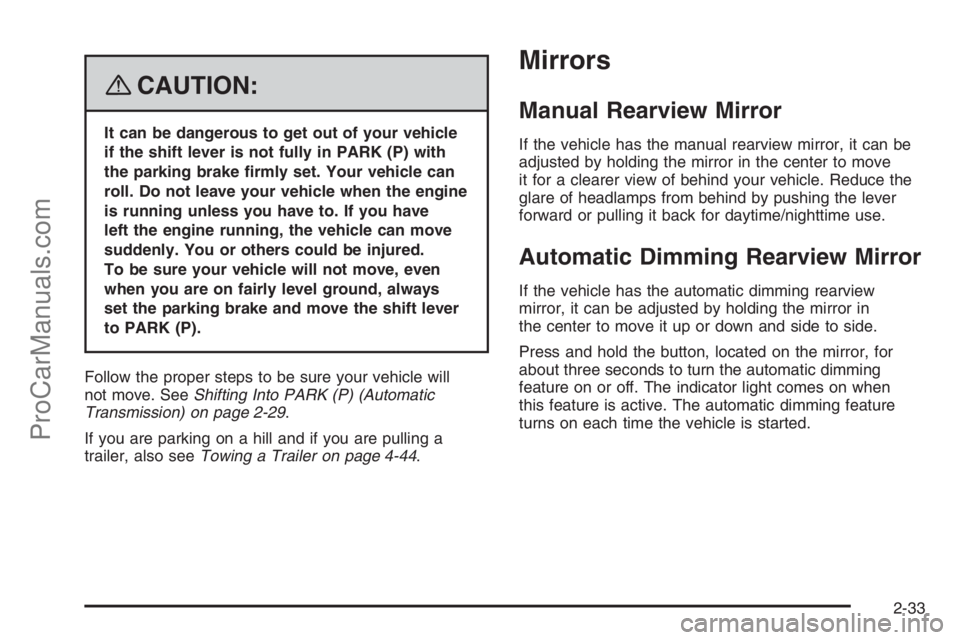
{CAUTION:
It can be dangerous to get out of your vehicle
if the shift lever is not fully in PARK (P) with
the parking brake �rmly set. Your vehicle can
roll. Do not leave your vehicle when the engine
is running unless you have to. If you have
left the engine running, the vehicle can move
suddenly. You or others could be injured.
To be sure your vehicle will not move, even
when you are on fairly level ground, always
set the parking brake and move the shift lever
to PARK (P).
Follow the proper steps to be sure your vehicle will
not move. SeeShifting Into PARK (P) (Automatic
Transmission) on page 2-29.
If you are parking on a hill and if you are pulling a
trailer, also seeTowing a Trailer on page 4-44.
Mirrors
Manual Rearview Mirror
If the vehicle has the manual rearview mirror, it can be
adjusted by holding the mirror in the center to move
it for a clearer view of behind your vehicle. Reduce the
glare of headlamps from behind by pushing the lever
forward or pulling it back for daytime/nighttime use.
Automatic Dimming Rearview Mirror
If the vehicle has the automatic dimming rearview
mirror, it can be adjusted by holding the mirror in
the center to move it up or down and side to side.
Press and hold the button, located on the mirror, for
about three seconds to turn the automatic dimming
feature on or off. The indicator light comes on when
this feature is active. The automatic dimming feature
turns on each time the vehicle is started.
2-33
ProCarManuals.com